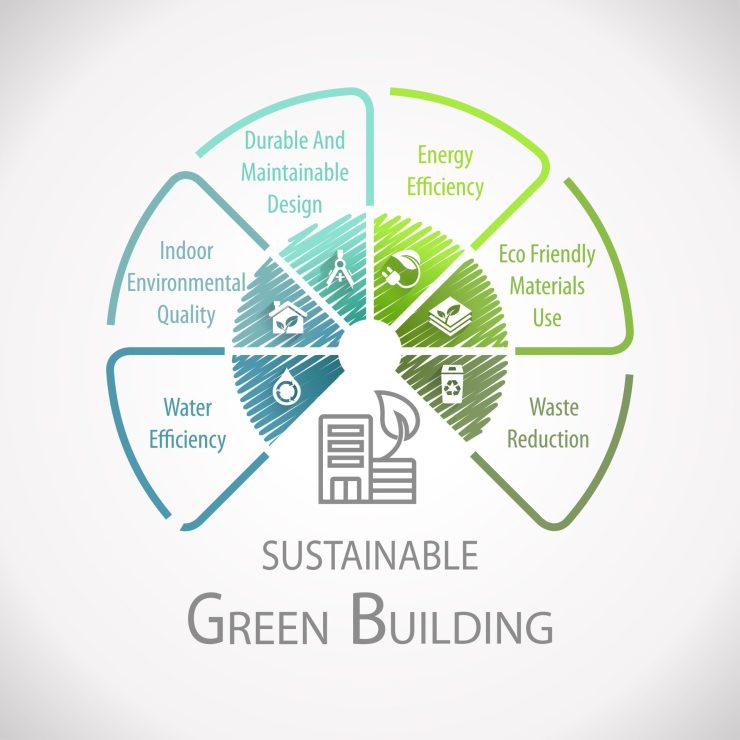By: Katie Tich, LEED Green Associate
The Sustainable Design department at Straughan offers consulting for all types of green building projects from a team of highly trained sustainability specialists. Last year, we highlighted here in our blog the LEED (Leadership in Energy and Environmental Design) certification program, one of the most common green building standards used in the United States. Many of our Sustainable Design projects involve consulting for owners and contractors to achieve their LEED certification goals for buildings, but there are several other sustainable building programs like LEED that offer unique perspectives and benefits. All of them have similar goals: to promote efficient, durable, and sustainable infrastructure that is healthy for the environment and for the people who use it. Let’s explore some other commonly used green building standards!
Green Globes
Green Globes is a certification system similar to LEED that evaluates the sustainable aspects of a building project across six categories: Project Management, Site, Energy, Water Efficiency, Materials, and Indoor Environment. Each category has a certain number of achievable points, which a project can earn by implementing sustainable building strategies.
The final rating that a building can achieve ranges from One to Four Green Globes. The level of certification depends on the number of total points a project achieves across all six categories out of the total number of points available. To earn the maximum, Four Green Globes, a project must earn at least 85% of all available points by using as many sustainable building strategies as possible.
The setup of this system is similar to LEED – earning points across different categories, achieving increasing levels of certification based on the total points achieved, tailoring the process to the client’s sustainability goals and the constraints of the project. Both LEED and Green Globes have benefits and drawbacks; choosing the best rating system for a project is very case-by-case and depends on specific project details. LEED has an established, rigorous certification program that is continually updated to address pertinent sustainability issues as they evolve over time. Green Globes is generally more affordable for large spaces; the online system is very user-friendly and collaborative, with a lot of options for assistance. Learn more about Green Globes at the Green Building Initiative website.
Parksmart
Parksmart is set up in a systematically similar way to LEED and Green Globes, with a selection of categories and credits that provide a variety of opportunities to earn points toward a sustainable certification. However—as you might discern from the name—Parksmart is specialized towards a very specific type of infrastructure: parking garages! That might sound surprising – of all the types of buildings, why parking garages? – but garages can actually make (or break) the sustainability of a project.
Parksmart offers Bronze, Silver, and Gold levels of certification corresponding to the number of total points earned out of the points available. Points are earned by opting into sustainability “Parksmart Measures” that contribute to more sustainable garage construction and operations. One energy-intensive feature of a garage, for instance, is lighting. Parksmart focuses on using more efficient lighting and signage throughout the garage to decrease energy use. Parksmart also offers points for providing preferred parking for electric vehicles and carpools, along with electric vehicle charging stations. There are even points available for using signage and space markings to optimize traffic flow and reduce idling emissions! Parksmart, and the emphasis it places on an aspect of infrastructure that is often overlooked, is quickly reaching the forefront of innovative sustainable design frameworks.
The Parksmart program is run by the United States Green Building Council (USGBC), the same organization that runs the LEED program. To learn more, visit the Parksmart website.
SITES
We’ve addressed buildings and even parking garages, but what about the most important part of a building – the land where it is built? Enter the SITES Rating System. This certification program is run by the Sustainable Sites Initiative, an organization that focuses on extending sustainable building practices beyond structures themselves and into the landscapes on which our infrastructure is built. LEED and Green Globes both have categories that address sustainable building site management and landscaping, but SITES provides a more comprehensive and in-depth review of site sustainable on projects.
SITES is an independent certification, but it can be earned on projects that are also earning a LEED or Green Globes certification. In fact, LEED offers pathways for projects to fulfill LEED credits using SITES requirements, which decreases credit overlap and makes it easier for projects to earn both! SITES is again similar in structure to LEED, Green Globes, and Parksmart, with a set of credit categories in which you can earn points and multiple tiers of certification depending on the number of points achieved during building design and construction.
SITES uses similar principles as the LEED framework for sustainable sites, but it takes those principles to a higher level. For instance, SITES credits are all solely focused on utilizing natural site conditions as effectively as possible to prevent habitat disturbance and promote native plant growth, water conservation, the use of outdoor spaces to improve human health, and more. SITES acknowledges the importance of all spaces in our built environment—not just individual buildings, but parks, landscapes, yards, gardens, streetscapes, and entire campuses of buildings. To learn more, visit the Sustainable Sites Initiative website.
With all of these complementary frameworks, the world of sustainable design is moving closer to an optimized, holistic approach to creating an efficient, effective and healthy built environment, both inside and outside (and in between, if we’re counting parking garages!)
